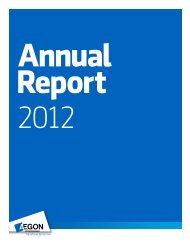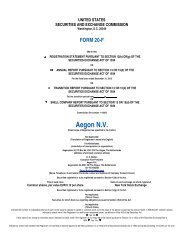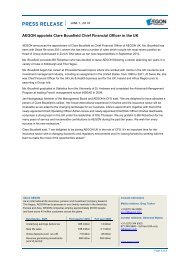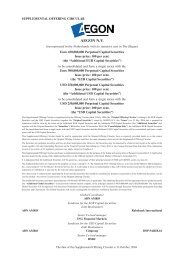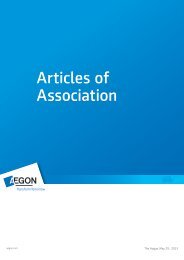Prospectus supplement US007924AH66 - Aegon
Prospectus supplement US007924AH66 - Aegon
Prospectus supplement US007924AH66 - Aegon
Create successful ePaper yourself
Turn your PDF publications into a flip-book with our unique Google optimized e-Paper software.
determine the amount of income accrued on the basis of the exchange rate in effect on the last day of<br />
the accrual period or, in the case of an accrual period that spans two taxable years, the exchange rate<br />
in effect on the last day of the part of the period within the taxable year. If the last day of the accrual<br />
period is within five business days of the date the interest payment is actually received, an electing<br />
accrual basis U.S. holder may instead translate that interest expense at the exchange rate in effect on<br />
the day of actual receipt. Any election to use the second accrual method will apply to all debt<br />
instruments held by the U.S. holder at the beginning of the first taxable year to which the election<br />
applies or thereafter acquired by the U.S. holder and will be irrevocable without the consent of the<br />
IRS.<br />
A U.S. holder utilizing either of the foregoing two accrual methods will recognize ordinary income<br />
or loss with respect to accrued interest income on the date of receipt of the interest payment (including<br />
a payment attributable to accrued but unpaid interest upon the sale or retirement of a debt security).<br />
The amount of ordinary income or loss will equal the difference between the U.S. dollar value of the<br />
interest payment received (determined on the date the payment is received) in respect of the accrual<br />
period and the U.S. dollar value of interest income that has accrued during that accrual period (as<br />
determined under the accrual method utilized by the U.S. holder).<br />
Foreign currency received as interest on the debt securities will have a tax basis equal to its U.S.<br />
dollar value at the time the interest payment is received. Gain or loss, if any, realized by a U.S. holder<br />
on a sale or other disposition of that foreign currency will be ordinary income or loss and will generally<br />
be income from sources within the United States for foreign tax credit limitation purposes.<br />
Interest on the debt securities received by a U.S. holder will be treated as foreign source income<br />
for the purposes of calculating that holder’s foreign tax credit limitation. The limitation on foreign<br />
taxes, if any, eligible for the U.S. foreign tax credit is calculated separately with respect to specific<br />
classes of income. The rules relating to foreign tax credits are complex. Each prospective investor<br />
should consult its own tax advisor regarding the availability of foreign tax credits.<br />
Original Issue Discount. A debt security, other than a debt security with a term of one year or less<br />
(a ‘‘short-term note’’), will be treated as issued at an original issue discount (‘‘OID’’, and a debt<br />
security issued with OID, a ‘‘discount note’’) for U.S. federal income tax purposes if the excess of the<br />
sum of all payments provided under the debt security, other than ‘‘qualified stated interest’’ payments<br />
(as defined below), over the issue price of the debt security is more than a ‘‘de minimis amount’’ (as<br />
defined below). ‘‘Qualified stated interest’’ is generally interest paid on a debt security that is<br />
unconditionally payable at least annually at a single fixed rate. The issue price of the debt securities<br />
will be the first price at which a substantial amount of the debt securities are sold to persons other<br />
than bond houses, brokers, or similar persons or organizations acting in the capacity of underwriters,<br />
placement agents, or wholesalers.<br />
In general, if the excess of the sum of all payments provided under the debt security other than<br />
qualified stated interest payments (the ‘‘stated redemption price at maturity’’) over its issue price is<br />
less than 0.25% of the debt security’s stated redemption price at maturity multiplied by the number of<br />
complete years to its maturity (the ‘‘de minimis amount’’), then such excess, if any, constitutes ‘‘de<br />
minimis OID’’ and the debt security is not a discount note. Unless the election described below under<br />
‘‘Election to Treat All Interest as OID’’ is made, a U.S. holder of a debt security with de minimis OID<br />
must include such de minimis OID in income as stated principal payments on the debt security are<br />
made. The includable amount with respect to each such payment will equal the product of the total<br />
amount of the debt security’s deminimis OID and a fraction, the numerator of which is the amount of<br />
the principal payment made and the denominator of which is the stated principal amount of the debt<br />
security.<br />
A U.S. holder will be required to include OID on a discount note in income for U.S. federal<br />
income tax purposes as it accrues, calculated on a constant-yield method, before the actual receipt of<br />
39



